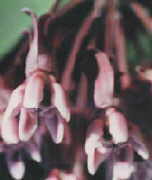 |
||
|
|
The monarch butterfly is common throughout the Americas
and has even been sighted across the ocean from its native
continent. Billions of these butterflies live in Mexico the
year round. But somehow, long ago, a subgroup developed the
habit of migrating between Mexico and the northern USA and
Canada. |
|
|
The mystery was finally solved in 1974 when, directed by the recovery of a few tagged butterflies, Ken and Kathy Brugger finally tracked the butterfly migrants were to their winter roosting sites: oyamel forest on particular group of isolated mountainsides in Mexico. But the migration still mystifies. Some scientists speculate that monarch butterflies may have followed the tropical milkweed as it extended its range northward after the last Ice Age. But we may never know why or how, instead of simply dying off, the wandering tropicals were able to fly back to Mexico when they encountered winter. Entomologists are now trying to figure out how they find the same sheltered mountainsides year after year. The phenomenon is even more stunning when one realizes that the cycle takes several generations to complete. So the monarch still has much to teach us. |
||
|
All monarch caterpillars feed exclusively on milkweed. A plant with fragrant multiple flower-heads and nutritional and medicinal properties, it is a tough and beautiful survivor like the monarch. The monarch's partnership with the milkweed gives it an unusual resistance to predators. The white sap that gives the milkweed its name is so bitter that most animals find it toxic. The awful taste is even more concentrated in a caterpillar that eats many milkweed leaves as it grows. A young bird who bites a striped caterpillar or a rust-coloured butterfly will be sick for hours. It will never attack such a creature again. |
|
|
|
The relationship between the monarch and the milkweed is an unusually clear example of the partnership that exists between plants and insects in general: in which the plant provides food for the insect and the insect helps to spread its pollen so that seeds can be formed. But the exclusivity of the monarch-milkweed bond carries disadvantages. Though dining on milkweed makes the insect very resistant to predators, the monarch caterpillar's reliance on a single food plant makes it vulnerable in other ways. Many North Americans have memories of vast flocks of migrating monarchs descending on public spaces or roosting in trees during the fall migration. But such large numbers are seldom seen nowadays. Because of tree-cutting in its Mexican winter habitat and the loss of wild meadow in its range through the United States and Canada, the gene pool that ventures from the tropics in the spring is an endangered phenomenon. |
||
|
The milkweed is considered to be an unwelcome visitor in most fields and gardens, but it continues to root in ditches, along railway tracks and in other neglected places. So the plant will likely always be with us. But the monarch butterfly must also cope with the stresses of migration, insecticides and lost habitat in its Mexican winter hideaway. It is the real victim of our battle against indigenous plants. |
||
|
The monarch's final life energy is spent carefully finding a host plant for each of her many eggs. Her unusual habit of depositing only one egg per plant helps to ensure the health of the milkweeds and therefore a continuous supply of food for the growing caterpillars. But the butterfly must find enough milkweeds so that the growing larvae can crawl from plant to plant in search of food. Until North Americans make peace with the existence of wild meadow where butterfly-friendly plants can flourish in abundance, the milkweed's lovely dependant will have a hard time finding enough homes for its eggs and larvae. So loving and saving the monarch means learning to love the milkweed and give it more space in our lives. |
||
|
There are many wonderful Monarch Butterfly sites on the internet: Start with the amazing Monarch Butterfly Hub at http://www.projectlinks.org/monarch/ For ideas on how to help the milkweed and the monarch, try http://www.milkweedfarm.com For daily updates on the current migration http://www.learner.org/jnorth/spring2002/species/monarch/ The University of Minnesota supplies great classroom material at http://www.monarchlab.umn.edu/ Come back and see me sometime! |
||




